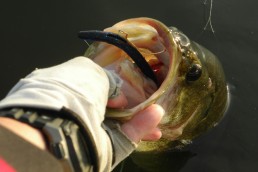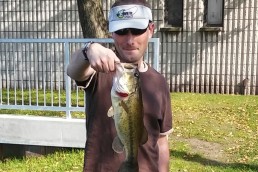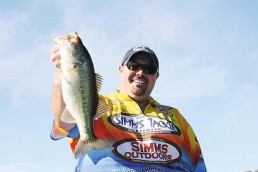Midwest Finesse Bass Tactics
SHARE THIS POST
Go-to Bass Tactics
As you hit the water any given day what is the first tactic that you will try for bass? I hope your first answer is to match the tactic with the time of the season. Most bass fisherman want to fish their strengths, but that may not be the best tactic to choose facing the specific conditions on the water that day.
To be the best bass fisherman that you can be you must fish in all type of conditions and still have a plan of how to put bass into the livewell. In the upper Midwest, finesse has ceased to be a fallback tactic; it is we can catch bass day in and day out. A spinning setup with 6-pound-test line is not part of the game for many anglers, but sometimes it is necessary gear for success. Let’s look at a few of the top Midwest finesse bass tactics. They might help you excel the next time you deal with a tough bite.
Neko Rig
The Neko Rig is the latest finesse tactic to take bass circles by storm. A Neko Rig makes your finesse worm or Trickstick stand up on end and walk across the bottom.
To rig the Neko Rig you need a nail weight to insert into the nose of the worm. You can purchase these at all your favorite tackle stores, or you can use a few other options. One is cutting 1/2- to 1-inch lengths from a roll of lead solder like plumbers use. These become your nail weights. Or, just screw a plain old screw into the end of your worm. On a hard bottom area, I like to use either a screw or a screw weight as my weight to feel the bottom and bait better than if I used a weight that is not exposed and up in the plastic.
Stick the worm in the middle with a drop shot hook so the hook points upwards towards the tail. Hooking up this way keeps the line from getting tangled up in the worm when you cast and also gives you a better hookup ratio as the hook points towards the top of the bass’ mouth.
I fish this Neko on a 7-foot, medium-action spinning setup spooled with 10-pound Sunline Siglon x8 braided line. The lure is on a 4-foot, 8-pound fluorocarbon leader.
Cast and let the bait sink to the bottom. Your goal is to walk this bait along the bottom to mimic a dying bluegill or perch nosing along the bottom. When you feel the bite, it is just like fishing a drop shot reel up the slack and lean into the fish to set the hook. Don’t yank or you might tear the light wire hook out of the bass’ mouth or break your line.
Jig worm
Are you enjoying this post?
You can be among the first to get the latest info on where to go, what to use and how to use it!
The jig worm tactic started in Minnesota with Connie Peterson and his Gopher Tackle Company. Connie wanted a bait combo to fish either in the weeds or on the rocks, so he came up with the Mushroom Head jig.
The Mushroom Head jig has a light wire hook, which allowed Connie to cast in the weeds. When the jig head got caught on the weeds, a quick snap would break the bait free. This made the bait deadly when teamed with a 4-inch ring worm or finesse worm. Snap the bait off of the weed and it looked like a minnow trying to get away. Most strikes came as the bait broke free from the weeds.
Team this setup with and small plastic and you are in business. Four-inch finesse worms, craws, Senkos, grubs and fluke tails are just to name a few of the bait options that you can use.
This tactic has turned into today’s Ned Rig. Take a 3- or 4-inch Seiko or Trickstick, trim it down a little, thread it onto the hook and start casting, dragging and doing nothing.
This setup works on the same spinning combo with braided line, but if you feel the bass are line shy, switch the braid out for a straight fluorocarbon line in 6- to 8-pound-test size. I might do one better and grab a reel spooled with Sunline 6-pound Super Natural mono. Like the braid, mono floats and makes the bait fall more slowly and not too deeply into the weeds. The slower fall triggers more bites when it is super tough.
Drop shot
The drop shot came to the U.S. at least 20 years ago from Japan. At first anglers only used it to fish deep, cold water and it excelled for that. Fishermen have since learned it can catch bass in when bass are on the beds in a few feet of water.
Many of the bait companies all now have drop shot baits in their lineups and rods and reel companies have also followed suit with specific rod designs. One big thing that has changed is the popular line choice, once 6- to 8-pound fluorocarbon, has trended towards 8- to 10-pound braided line and a fluorocarbon leader. The switch allows you to feel more strikes. Braids are also more abrasion resistant and stronger in thinner diameters. You can fish the drop shot in more areas and not just in open water where your chances of getting snagged up are slim.
If you are looking to put more bass in your boat this season when the bite is tough give some of these finesse tactics a try. I think you will be surprised at the number and size of fish you catch. Finesse fishing does not mean small fish. Many times finesse tactics can score one of your best catches of the season.
MWO
SHARE THIS POST
Did you enjoy this post?
You can be among the first to get the latest info on where to go, what to use and how to use it!
Scott Petersen
Scott Petersen has been writing for the past 30 years. A Minnesota native, he has a passion to fish all seasons on ice and open water. “One of my main goals is to teach people how to fish through my articles and sport-show seminars.”



